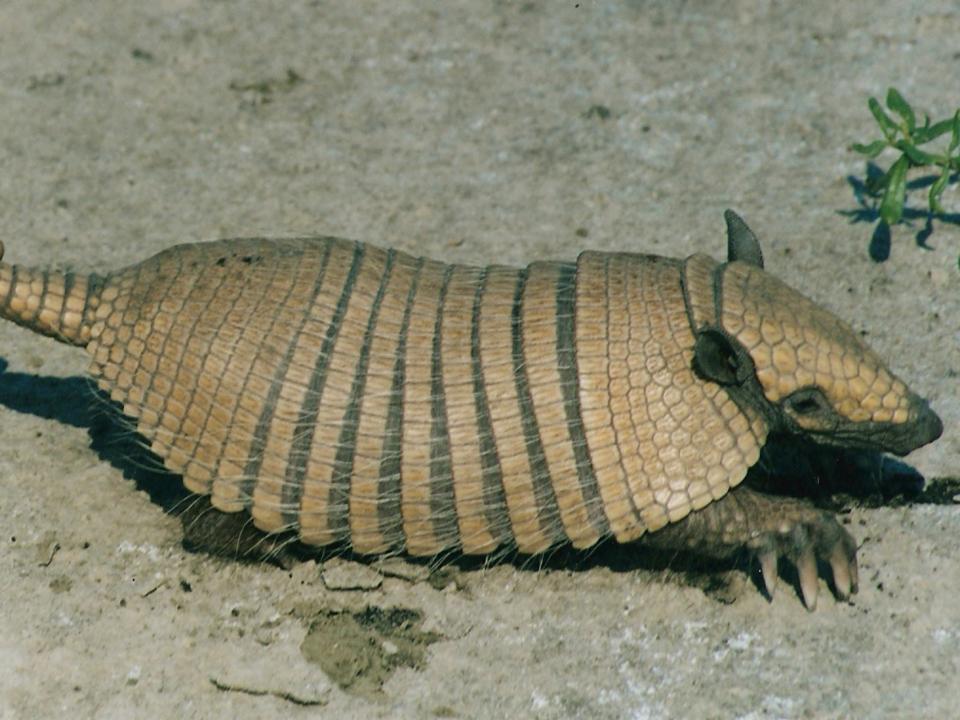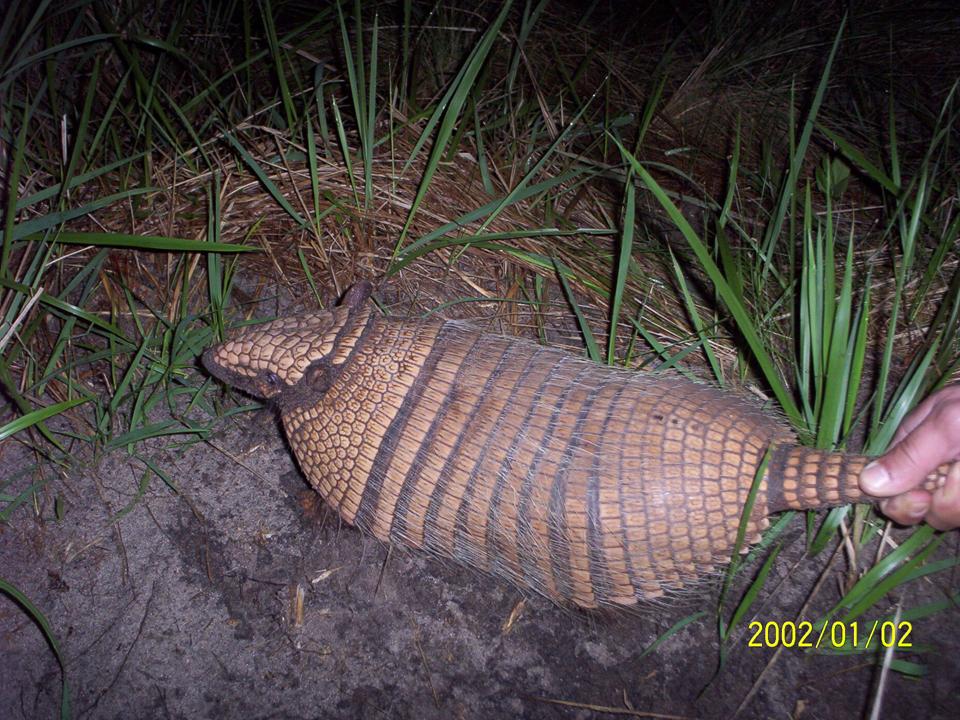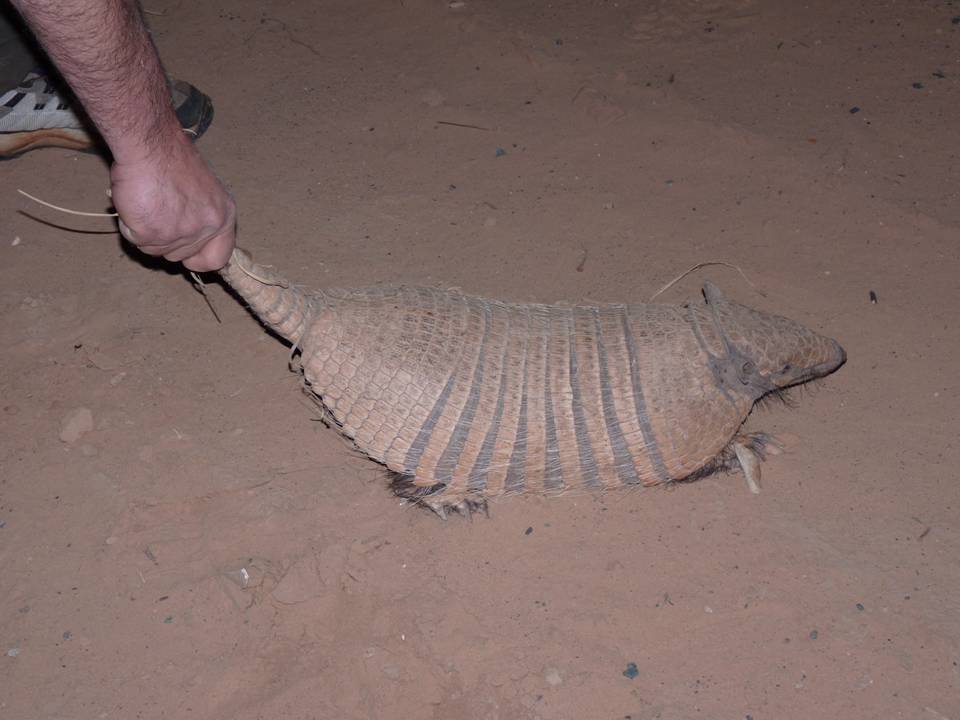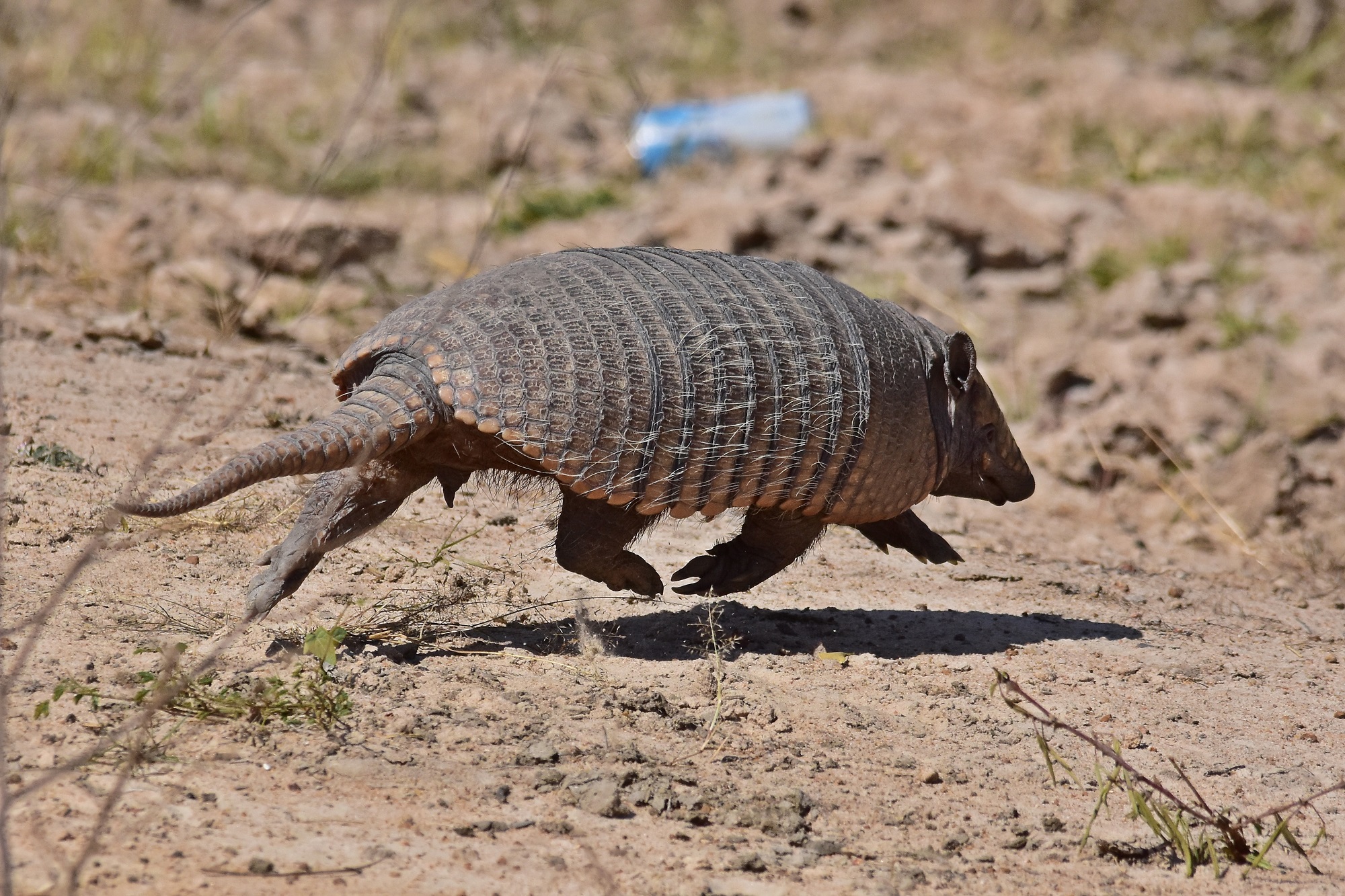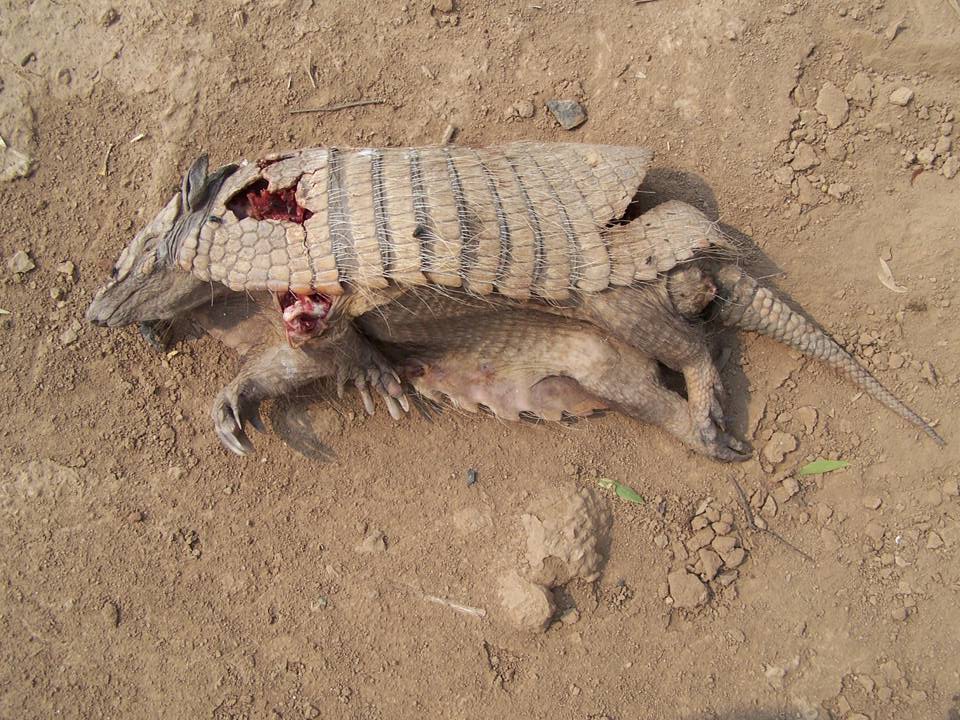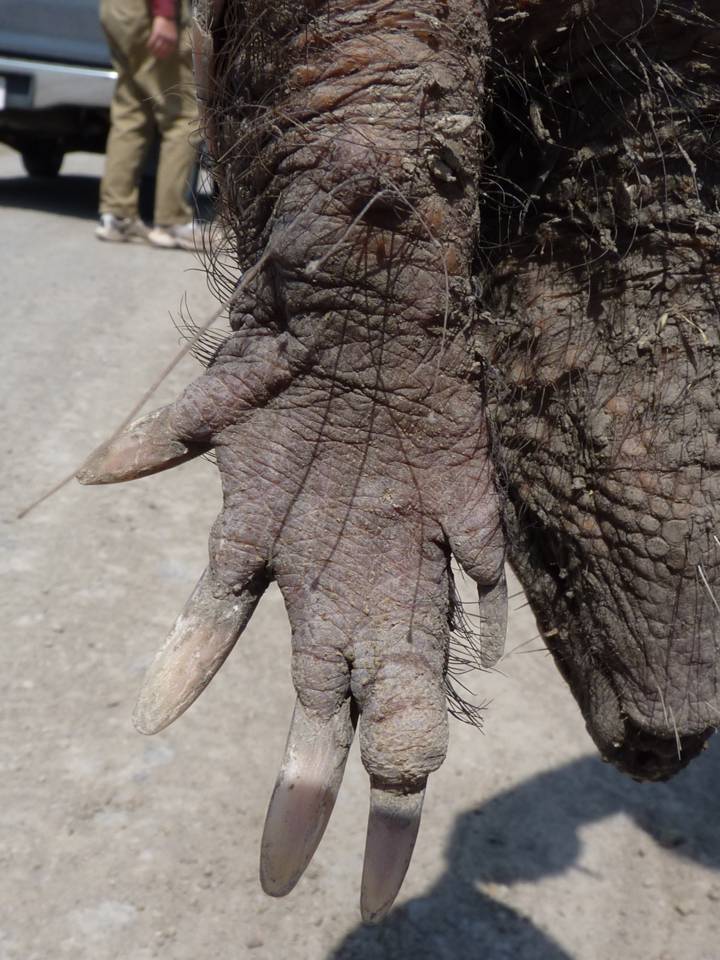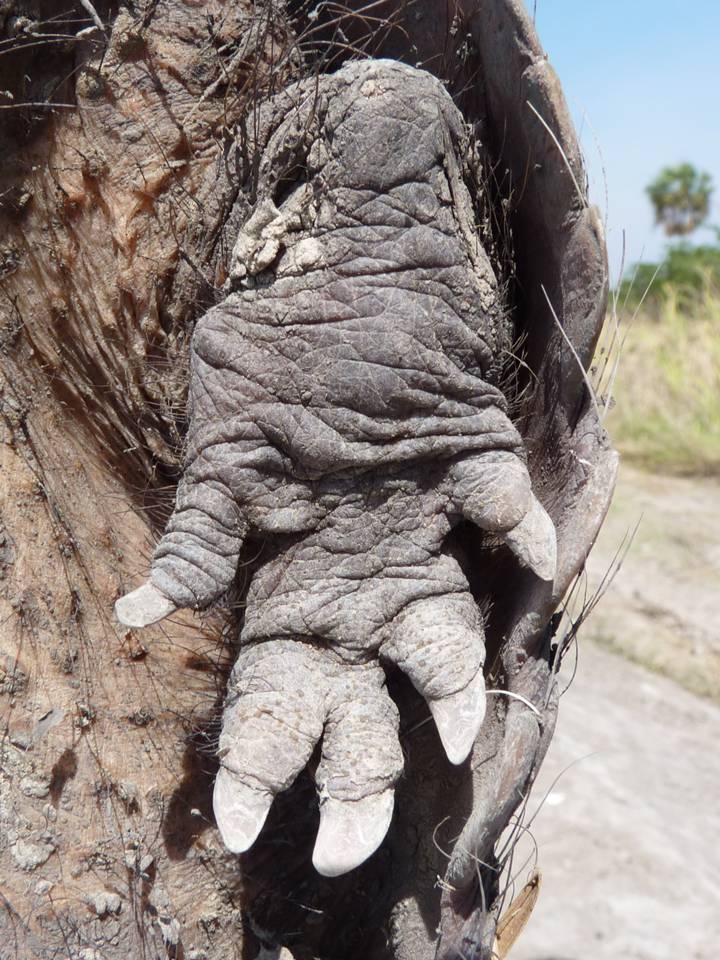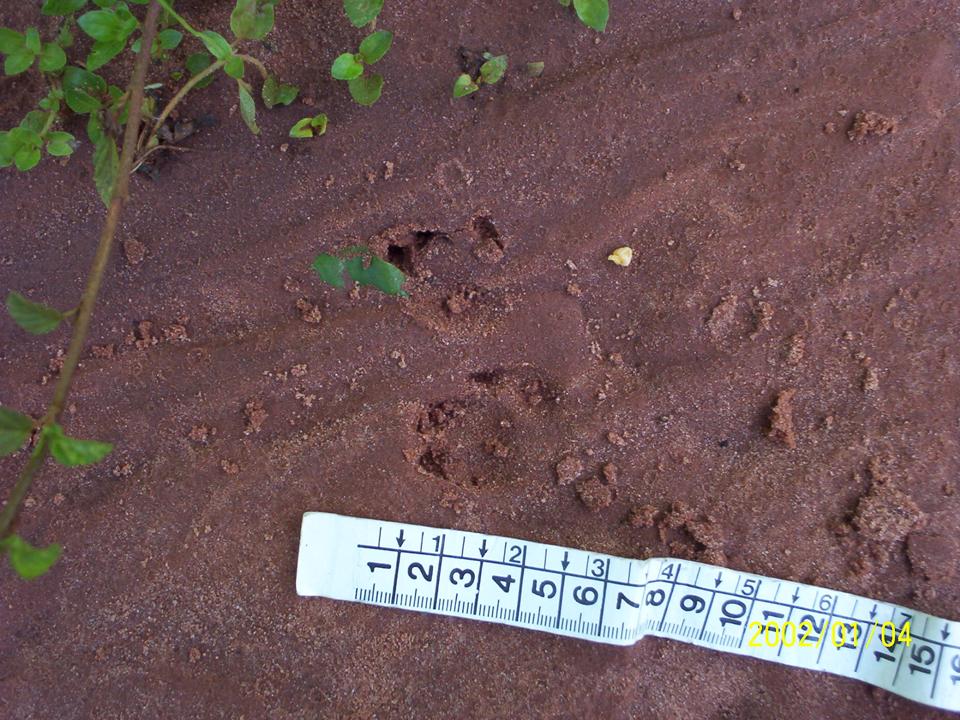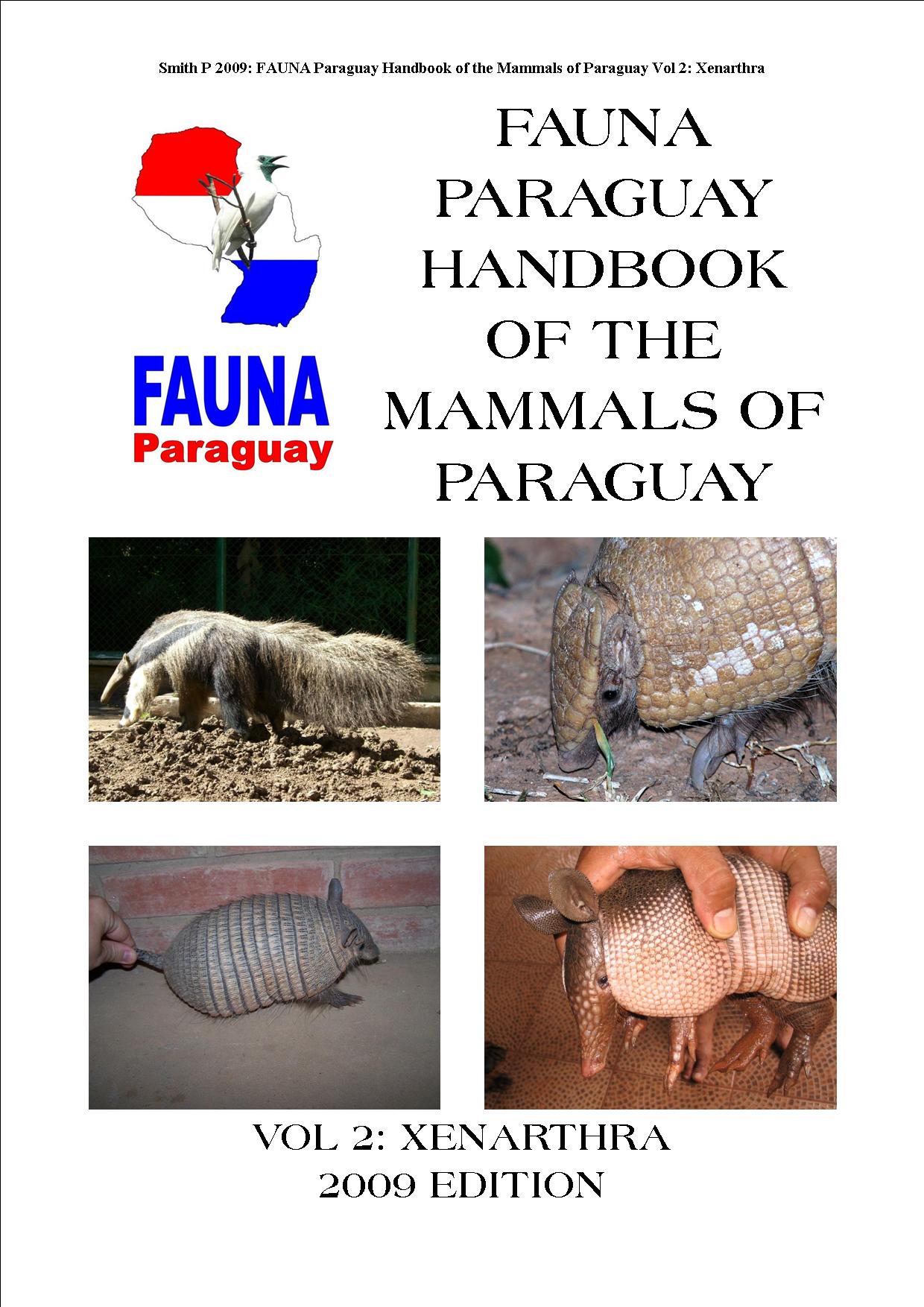Designed by Paul Smith 2006. This website is copyrighted by law.
Material contained herewith may not be used without the prior written permission of FAUNA Paraguay.
Photographs on this web-site were taken by Paul Smith, Sergio Rios, Helen Pheasey and Alberto Esquivel and are used with their permission.
Material contained herewith may not be used without the prior written permission of FAUNA Paraguay.
Photographs on this web-site were taken by Paul Smith, Sergio Rios, Helen Pheasey and Alberto Esquivel and are used with their permission.
SIX-BANDED ARMADILLO Euphractus sexcinctus
Smith P 2007 - FAUNA Paraguay Handbook of the Mammals of Paraguay Number 5 Six-banded Armadillo Euphractus sexcinctus
Pdf file 970kb
With the exception of the rare Giant Armadillo, this is the largest member of the Armadillo family present in Paraguay. Despite the name up to 8 movable bands may be present (you do not count the first band which is joined to the front of the carapace!) with a fine coat of whitish-tan hair sprouting between them. It is one of the most widespread Armadillos in Paraguay occurring in both dry and humid areas of the Chaco and the Orient. This species is hunted for food in some areas, though a perceived association between this species and the transmission of leprosy (the species has nothing to do with the transmission of the disease!) means that in certain areas it is not consumed. Six-banded Armadillos are omnivores and are capable of giving a severe bite.
Click on the images to enlarge them.
Smith P 2007 - FAUNA Paraguay Handbook of the Mammals of Paraguay Number 5 Six-banded Armadillo Euphractus sexcinctus
Pdf file 970kb
With the exception of the rare Giant Armadillo, this is the largest member of the Armadillo family present in Paraguay. Despite the name up to 8 movable bands may be present (you do not count the first band which is joined to the front of the carapace!) with a fine coat of whitish-tan hair sprouting between them. It is one of the most widespread Armadillos in Paraguay occurring in both dry and humid areas of the Chaco and the Orient. This species is hunted for food in some areas, though a perceived association between this species and the transmission of leprosy (the species has nothing to do with the transmission of the disease!) means that in certain areas it is not consumed. Six-banded Armadillos are omnivores and are capable of giving a severe bite.
Click on the images to enlarge them.
FIGURE 1 - (FPMAM44PH) Adult with 7 bands, location unknown (Alberto Esquivel undated).
FIGURE 2 - (FPMAM45PH) Adult with 7 bands rear view, Estancia Laguna Blanca, Dep San Pedro (Paul Smith November 2005).
FIGURE 3 - (FPMAM924PH) Adult, near Loma Plata, Departamento Presidente Hayes (Paul Smith November 2010).
FIGURE 4 - (FPMAM1186PH) Adult, San Carlos del Apa, Departamento Concepción (Sergio Rios July 2017).
FIGURE 5 - (FPMAM46PH) Adult roadkill with 7 bands, Central Chaco (Paul Smith September 2006).
FIGURE 6 - (FPMAM1003PH) Forefoot, near Toro Pampa, Departamento Alto Paraguay (Paul Smith August 2011).
FIGURE 7 - (FPMAM1004PH) Hind foot, near Toro Pampa, Departamento Alto Paraguay (Paul Smith August 2011).
FIGURE 8 - (FPMAM47PH) Footprints from Estancia Laguna Blanca, Dep San Pedro (Paul Smith November 2005).
FIGURE 9 - (FPMAM1154PH) Scute details, Estancia Laguna Blanca, Dep San Pedro (Helen Pheasey December 2012).
FIGURE 2 - (FPMAM45PH) Adult with 7 bands rear view, Estancia Laguna Blanca, Dep San Pedro (Paul Smith November 2005).
FIGURE 3 - (FPMAM924PH) Adult, near Loma Plata, Departamento Presidente Hayes (Paul Smith November 2010).
FIGURE 4 - (FPMAM1186PH) Adult, San Carlos del Apa, Departamento Concepción (Sergio Rios July 2017).
FIGURE 5 - (FPMAM46PH) Adult roadkill with 7 bands, Central Chaco (Paul Smith September 2006).
FIGURE 6 - (FPMAM1003PH) Forefoot, near Toro Pampa, Departamento Alto Paraguay (Paul Smith August 2011).
FIGURE 7 - (FPMAM1004PH) Hind foot, near Toro Pampa, Departamento Alto Paraguay (Paul Smith August 2011).
FIGURE 8 - (FPMAM47PH) Footprints from Estancia Laguna Blanca, Dep San Pedro (Paul Smith November 2005).
FIGURE 9 - (FPMAM1154PH) Scute details, Estancia Laguna Blanca, Dep San Pedro (Helen Pheasey December 2012).
LINKS TO DOWNLOADABLE OPEN ACCESS REFERENCES USED IN THE PREPARATION OF THE FAUNA PARAGUAY HANDBOOK OF THE MAMMALS OF PARAGUAY SPECIES ACCOUNT FOR THIS SPECIES:
Ávila-Pires FD de 1965 - The Type Specimens of Brazilian Mammals Collected by Prince Maximillian zu Wied - AMNH Novitates 2209.
Brooks DM 1995 - Distribution and Limiting Factors of Edentates in the Paraguayan Chaco - Edentata 2: p10-15.
Ceresoli N, Jimenez GT, Duque EF 2003 - Datos Morfómetricos de los Armadillos del Complejo Ecológico de Sánz Peña, Provincia del Chaco, Argentina - Edentata 5: p35-37.
Dalponte JC, Tavares-Filho JA 2004 - Diet of the Yellow Armadillo Euphractus sexcinctus in South-Central Brazil - Edentata 6: p37-41.
Desbiez ALJ 2006 - Chasing Behavior in Yellow Armadillos, Euphractus sexcinctus, in the Brazilian Pantanal - Edentata 7: p51-53.
Myers P, Espinosa R, Parr CS, Jones T, Hammond GS, Dewey A 2006 - The Animal Diversity Web (online). Accessed December 2007.
Redford KH 1994 - The Edentates of the Cerrado - Edentata 1: p4-10.
Redford KH, Wetzel RM 1985 - Euphractus sexcinctus - Mammalian Species 252: p1-4.
Ávila-Pires FD de 1965 - The Type Specimens of Brazilian Mammals Collected by Prince Maximillian zu Wied - AMNH Novitates 2209.
Brooks DM 1995 - Distribution and Limiting Factors of Edentates in the Paraguayan Chaco - Edentata 2: p10-15.
Ceresoli N, Jimenez GT, Duque EF 2003 - Datos Morfómetricos de los Armadillos del Complejo Ecológico de Sánz Peña, Provincia del Chaco, Argentina - Edentata 5: p35-37.
Dalponte JC, Tavares-Filho JA 2004 - Diet of the Yellow Armadillo Euphractus sexcinctus in South-Central Brazil - Edentata 6: p37-41.
Desbiez ALJ 2006 - Chasing Behavior in Yellow Armadillos, Euphractus sexcinctus, in the Brazilian Pantanal - Edentata 7: p51-53.
Myers P, Espinosa R, Parr CS, Jones T, Hammond GS, Dewey A 2006 - The Animal Diversity Web (online). Accessed December 2007.
Redford KH 1994 - The Edentates of the Cerrado - Edentata 1: p4-10.
Redford KH, Wetzel RM 1985 - Euphractus sexcinctus - Mammalian Species 252: p1-4.


SIX-BANDED ARMADILLO Euphractus sexcinctus
DORSAL (FPMAM1155PH); VENTRAL (FPMAM1156PH); LATERAL (FPMAM1157PH)
Skull photos Helen Pheasey
DORSAL (FPMAM1155PH); VENTRAL (FPMAM1156PH); LATERAL (FPMAM1157PH)
Skull photos Helen Pheasey
